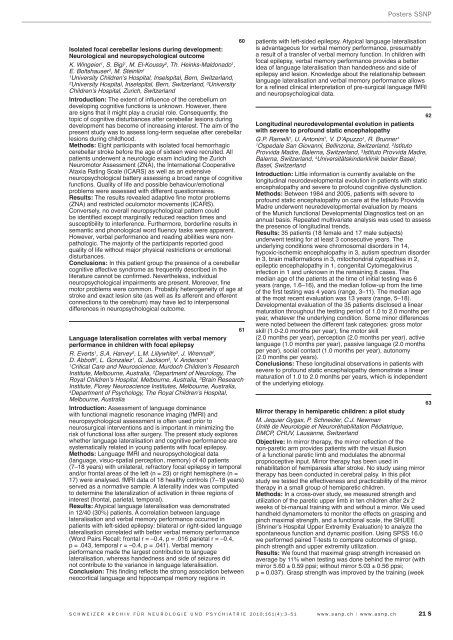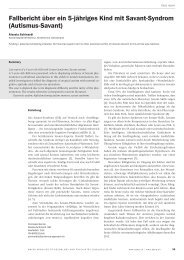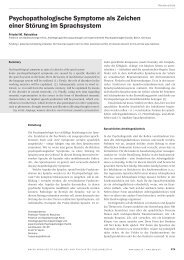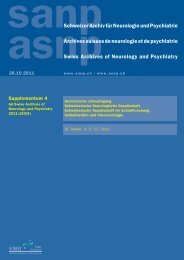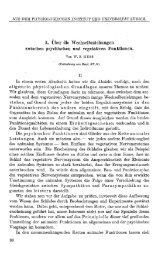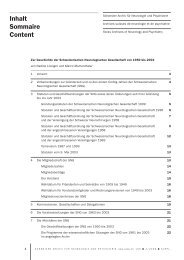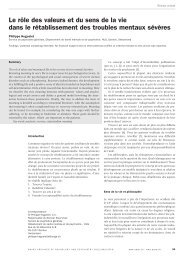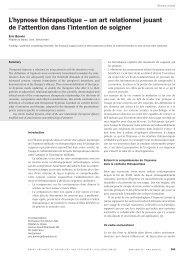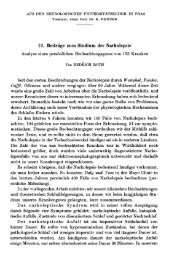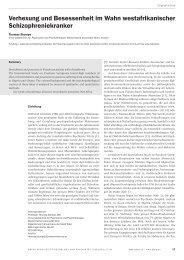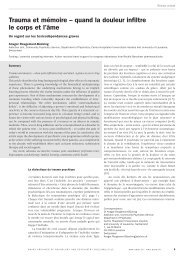Schweizer Archiv für Neurologie und Psychiatrie ... - Sanp.ch
Schweizer Archiv für Neurologie und Psychiatrie ... - Sanp.ch
Schweizer Archiv für Neurologie und Psychiatrie ... - Sanp.ch
Create successful ePaper yourself
Turn your PDF publications into a flip-book with our unique Google optimized e-Paper software.
Posters SSNP<br />
60<br />
Isolated focal cerebellar lesions during development:<br />
Neurological and neuropsy<strong>ch</strong>ological outcome<br />
K. Wingeier 1 , S. Bigi 1 , M. El-Koussy 2 , Th. Heinks-Maldonado 1 ,<br />
E. Boltshauser 3 , M. Steinlin 1<br />
1<br />
University Children’s Hospital, Inselspital, Bern, Switzerland,<br />
2<br />
University Hospital, Inselspital, Bern, Switzerland, 3 University<br />
Children’s Hospital, Zuri<strong>ch</strong>, Switzerland<br />
Introduction: The extent of influence of the cerebellum on<br />
developing cognitive functions is unknown. However, there<br />
are signs that it might play a crucial role. Consequently, the<br />
topic of cognitive disturbances after cerebellar lesions during<br />
development has become of increasing interest. The aim of the<br />
present study was to assess long-term sequelae after cerebellar<br />
lesions during <strong>ch</strong>ildhood.<br />
Methods: Eight participants with isolated focal hemorrhagic<br />
cerebellar stroke before the age of sixteen were recruited. All<br />
patients <strong>und</strong>erwent a neurologic exam including the Zuri<strong>ch</strong><br />
Neuromotor Assessment (ZNA), the International Cooperative<br />
Ataxia Rating Scale (ICARS) as well as an extensive<br />
neuropsy<strong>ch</strong>ological battery assessing a broad range of cognitive<br />
functions. Quality of life and possible behaviour/emotional<br />
problems were assessed with different questionnaires.<br />
Results: The results revealed adaptive fine motor problems<br />
(ZNA) and restricted oculomotor movements (ICARS).<br />
Conversely, no overall neuropsy<strong>ch</strong>ological pattern could<br />
be identified except marginally reduced reaction times and<br />
susceptibility to interference. Furthermore, borderline results in<br />
semantic and phonological word fluency tasks were apparent.<br />
However, verbal performance and reading abilities were nonpathologic.<br />
The majority of the participants reported good<br />
quality of life without major physical restrictions or emotional<br />
disturbances.<br />
Conclusions: In this patient group the presence of a cerebellar<br />
cognitive affective syndrome as frequently described in the<br />
literature cannot be confirmed. Nevertheless, individual<br />
neuropsy<strong>ch</strong>ological impairments are present. Moreover, fine<br />
motor problems were common. Probably heterogeneity of age at<br />
stroke and exact lesion site (as well as its afferent and efferent<br />
connections to the cerebrum) may have led to interpersonal<br />
differences in neuropsy<strong>ch</strong>ological outcome.<br />
61<br />
Language lateralisation correlates with verbal memory<br />
performance in <strong>ch</strong>ildren with focal epilepsy<br />
R. Everts 1 , S.A. Harvey 2 , L.M. Lillywhite 3 , J. Wrennall 4 ,<br />
D. Abbott 3 , L. Gonzalez 1 , G. Jackson 3 , V. Anderson 1<br />
1<br />
Critical Care and Neuroscience, Murdo<strong>ch</strong> Children’s Resear<strong>ch</strong><br />
Institute, Melbourne, Australia, 2 Department of Neurology, The<br />
Royal Children’s Hospital, Melbourne, Australia, 3 Brain Resear<strong>ch</strong><br />
Institute, Florey Neuroscience Institutes, Melbourne, Australia,<br />
4<br />
Department of Psy<strong>ch</strong>ology, The Royal Children’s Hospital,<br />
Melbourne, Australia<br />
Introduction: Assessment of language dominance<br />
with functional magnetic resonance imaging (fMRI) and<br />
neuropsy<strong>ch</strong>ological assessment is often used prior to<br />
neurosurgical interventions and is important in minimizing the<br />
risk of functional loss after surgery. The present study explores<br />
whether language lateralisation and cognitive performance are<br />
systematically related in young patients with focal epilepsy.<br />
Methods: Language fMRI and neuropsy<strong>ch</strong>ological data<br />
(language, visuo-spatial perception, memory) of 40 patients<br />
(7–18 years) with unilateral, refractory focal epilepsy in temporal<br />
and/or frontal areas of the left (n = 23) or right hemisphere (n =<br />
17) were analysed. fMRI data of 18 healthy controls (7–18 years)<br />
served as a normative sample. A laterality index was computed<br />
to determine the lateralization of activation in three regions of<br />
interest (frontal, parietal, temporal).<br />
Results: Atypical language lateralisation was demonstrated<br />
in 12/40 (30%) patients. A correlation between language<br />
lateralisation and verbal memory performance occurred in<br />
patients with left-sided epilepsy: bilateral or right-sided language<br />
lateralisation correlated with better verbal memory performance<br />
(Word Pairs Recall: frontal r = –0.4, p = .016 parietal r = –0.4,<br />
p = .043, temporal r = –0.4, p = .041). Verbal memory<br />
performance made the largest contribution to language<br />
lateralisation, whereas handedness and side of seizures did<br />
not contribute to the variance in language lateralisation.<br />
Conclusion: This finding reflects the strong association between<br />
neocortical language and hippocampal memory regions in<br />
patients with left-sided epilepsy. Atypical language lateralisation<br />
is advantageous for verbal memory performance, presumably<br />
a result of a transfer of verbal memory function. In <strong>ch</strong>ildren with<br />
focal epilepsy, verbal memory performance provides a better<br />
idea of language lateralisation than handedness and side of<br />
epilepsy and lesion. Knowledge about the relationship between<br />
language lateralisation and verbal memory performance allows<br />
for a refined clinical interpretation of pre-surgical language fMRI<br />
and neuropsy<strong>ch</strong>ological data.<br />
62<br />
Longitudinal neurodevelopmental evolution in patients<br />
with severe to profo<strong>und</strong> static encephalopathy<br />
G.P. Ramelli 1 , U. Antonini 1 , V. D’Apuzzo 1 , R. Brunner 1<br />
1<br />
Ospedale San Giovanni, Bellinzona, Switzerland, 2 Istituto<br />
Provvida Madre, Balerna, Switzerland, 3 Istituto Provvida Madre,<br />
Balerna, Switzerland, 4 Universitätskinderklinik beider Basel,<br />
Basel, Switzerland<br />
Introduction: Little information is currently available on the<br />
longitudinal neurodevelopmental evolution in patients with static<br />
encephalopathy and severe to profo<strong>und</strong> cognitive dysfunction.<br />
Methods: Between 1984 and 2005, patients with severe to<br />
profo<strong>und</strong> static encephalopathy on care at the Istituto Provvida<br />
Madre <strong>und</strong>erwent neuredevelopmental evaluation by means<br />
of the Muni<strong>ch</strong> functional Developmental Diagnostics test on an<br />
annual basis. Repeated multivariate analysis was used to assess<br />
the presence of longitudinal trends.<br />
Results: 35 patients (18 female and 17 male subjects)<br />
<strong>und</strong>erwent testing for at least 3 consecutive years. The<br />
<strong>und</strong>erlying conditions were <strong>ch</strong>romosomal disorders in 14,<br />
hypoxic-is<strong>ch</strong>emic encephalopathy in 3, autism spectrum disorder<br />
in 3, brain malformations in 3, mito<strong>ch</strong>ondrial cytopathies in 2,<br />
epileptic encephalopathy in 1, congenital Cytomegalovirus<br />
infection in 1 and unknown in the remaining 8 cases. The<br />
median age of the patients at the time of initial testing was 6<br />
years (range, 1.6–16), and the median follow-up from the time<br />
of the first testing was 4 years (range, 3–11). The median age<br />
at the most recent evaluation was 13 years (range, 5–18).<br />
Developmental evaluation of the 35 patients disclosed a linear<br />
maturation throughout the testing period of 1.0 to 2.0 months per<br />
year, whatever the <strong>und</strong>erlying condition. Some minor differences<br />
were noted between the different task categories: gross motor<br />
skill (1.0-2.0 months per year), fine motor skill<br />
(2.0 months per year), perception (2.0 months per year), active<br />
language (1.0 months per year), passive language (2.0 months<br />
per year), social contact (1.0 months per year), autonomy<br />
(2.0 months per years).<br />
Conclusions: These longitudinal observations in patients with<br />
severe to profo<strong>und</strong> static encephalopathy demonstrate a linear<br />
maturation of 1.0 to 2.0 months per years, whi<strong>ch</strong> is independent<br />
of the <strong>und</strong>erlying etiology.<br />
63<br />
Mirror therapy in hemiparetic <strong>ch</strong>ildren: a pilot study<br />
M. Jequier Gygax, P. S<strong>ch</strong>neider, C.J. Newman<br />
Unité de <strong>Neurologie</strong> et Neuroréhabilitation Pédiatrique,<br />
DMCP, CHUV, Lausanne, Switzerland<br />
Objective: In mirror therapy, the mirror reflection of the<br />
non-paretic arm provides patients with the visual illusion<br />
of a functional paretic limb and modulates the abnormal<br />
proprioceptive input. Mirror therapy has been used in<br />
rehabilitation of hemiparesis after stroke. No study using mirror<br />
therapy has been conducted in cerebral palsy. In this pilot<br />
study we tested the effectiveness and practicability of the mirror<br />
therapy in a small group of hemiparetic <strong>ch</strong>ildren.<br />
Methods: In a cross-over study, we measured strength and<br />
utilization of the paretic upper limb in ten <strong>ch</strong>ildren after 2x 2<br />
weeks of bi-manual training with and without a mirror. We used<br />
handheld dynamometers to monitor the effects on grasping and<br />
pin<strong>ch</strong> maximal strength, and a functional scale, the SHUEE<br />
(Shriner’s Hospital Upper Extremity Evaluation) to analyze the<br />
spontaneous function and dynamic position. Using SPSS 16.0<br />
we performed paired T-tests to compare outcomes of grasp,<br />
pin<strong>ch</strong> strength and upper extremity utilization.<br />
Results: We fo<strong>und</strong> that maximal grasp strength increased on<br />
average by 11% when testing was done behind the mirror (with<br />
mirror 5.60 ± 0.59 ppsi; without mirror 5.03 ± 0.56 ppsi;<br />
p = 0.037). Grasp strength was improved by the training (week<br />
SCHWEIZER ARCHIV FÜR NEUROLOGIE UND PSYCHIATRIE 2010;161(4):3–51 www.sanp.<strong>ch</strong> | www.asnp.<strong>ch</strong> 21 S


